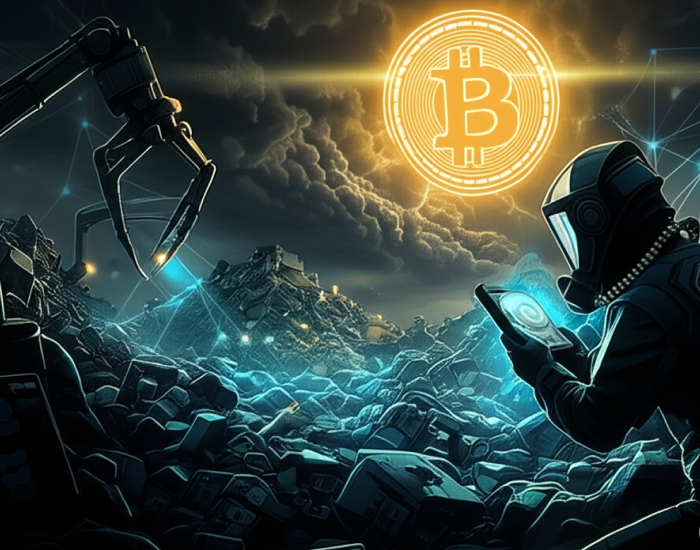Trash to treasure stories often revolve around luck, but this one is pure persistence. Let’s break it down. In 2013, James Howells, an IT worker from Newport, Wales, accidentally threw away a hard drive during a house clean-up. On that drive is a private keys to 8,000 Bitcoins—now worth over $742 million. This is no ordinary tale of misplacement. It’s a real-world crypto adventure filled with tech drama and legislative pushbacks.
A $742 Million Mistake
James Howells mined his Bitcoins in 2009 when the digital currency was virtually worthless. Like many early adopters, he didn’t foresee Bitcoin’s meteoric rise. So, when he mistakenly tossed the hard drive, he wasn’t overly concerned. That changed quickly as Bitcoin’s price soared. By 2017, his mistake became a global headline. In 2021, his fortune was estimated at $280 million. By 2024, it had surged to over $742 million.
The catch? The drive now lies buried under thousands of tons of trash in Newport’s landfill.
The Tech Blueprint to Unearth Treasure
Howells’ strategy to recover the hard drive is more sci-fi than scrap yard. He’s proposed a $11 million excavation plan involving:
- Robotic arms and AI-powered scanners
- Environmental experts to prevent contamination
- A data recovery team on standby for drive extraction

The project even has venture capital backing and partnerships with firms specializing in e-waste and tech recovery. According to Howells, recovering the drive has a 60% to 80% chance of success, assuming it hasn’t suffered catastrophic damage.
Political Resistance and Bureaucratic Hurdles
Despite his readiness and funding, Howells faces one key obstacle: Newport City Council. Officials cite environmental concerns and safety risks as reasons to deny excavation permits. They argue that any attempt to dig up the landfill could set dangerous precedents for future treasure hunters.
This has turned the Trash to Treasure saga into a bureaucratic standoff. Howells accuses the council of blocking innovation and economic opportunity, while officials remain unmoved.
What Makes This Quest Unique?
Comparing Bitcoin Losses
| Name | Bitcoin Lost | Estimated Value (2024) | Recovery Effort? |
| James Howells | 8,000 BTC | $742 Million | Ongoing |
| Stefan Thomas | 7,002 BTC | $649 Million | None (forgotten password) |
| Mt. Gox Victims | ~850,000 BTC | Over $78 Billion | Partial through courts |
Unlike others who gave up, Howells turned his loss into a mission. His relentless drive to reclaim his Bitcoin fortune symbolizes hope for digital asset holders.
The Bigger Picture: Trash to Treasure in the Crypto Age
This story isn’t just about money. It underscores deeper issues in the digital finance world:
- Digital Ownership: Bitcoin is secure but unforgiving. Lose your keys, lose your wealth.
- Tech Dependence: Many lack backup protocols for safeguarding private keys.
- Legal Grey Areas: Authorities struggle to govern assets with no physical form.
Howells’ story makes us ask: how do we secure assets that exist only as code?
Innovations Sparked by the Search
The media buzz and technical challenges of this Trash to Treasure journey have fueled innovation:
- Improved Data Recovery Tools: Companies are investing in advanced techniques to restore damaged drives.
- Cold Storage Solutions: More secure offline Bitcoin wallets are gaining popularity.
- Public-Private Partnerships: Governments and private firms are beginning to collaborate on e-waste recovery.
A Media Magnet with a Message
Howells’ quest has earned him interviews with global media, appearances in documentaries, and even interest from Netflix producers. But more than fame, he’s igniting a conversation around Bitcoin’s permanence—and its fragility.
“People think Bitcoin is digital and safe, but it’s only safe if you manage your keys,” says Howells. His story is now a cautionary tale for new crypto investors.
From Mistake to Movement
What began as a moment of carelessness has evolved into a cultural moment. Trash to Treasure isn’t just a story—it’s a reflection of our digital future. It shows how:
- Fortune favors the bold, especially in uncharted digital territories.
- Persistence can rival luck, especially when millions are on the line.
- Trash can become treasure, with the right mix of technology, tenacity, and timing.
Court Ruling: What Was Decided?
In early January 2025, the UK High Court dismissed James Howells’ lawsuit seeking permission to dig up Newport’s Docksway landfill. Thus, defeating his Trash-to-treasury recover effort of the hard drive containing 8,000 BTC, now valued between $740–770 million
Judge Andrew Keyser KC ruled that:
- Howells lacked “reasonable grounds” to proceed.
- He had “no realistic prospect of success” at trial
- Once discarded, the hard drive legally became council property under UK waste laws (Control of Pollution Act 1974)
- The landfill’s existing environmental permits prohibit excavation, rendering the recovery legally impossible
🗺️ Court of Appeal: Final Straw
In March 2025, the Court of Appeal also rejected Howells’ appeal, reiterating that there was no realistic prospect or compelling legal ground for his claim. He then indicated plans to approach the European Court of Human Rights (ECHR) to revive the hope for his trash to treasury quest, though its decisions cannot reverse UK court rulings.
Final Thoughts: A New Kind of Treasure Hunt
James Howells may still be waiting for that golden moment when his hard drive resurfaces. But in the process, he’s reshaped how we think about value, risk, and redemption in the digital age.
In a world where data is currency and landfills might hide fortunes, this story reminds us: never underestimate what might lie beneath the surface—literally..
RECAP:
The “Trash to Treasure” story centers on James Howells, who accidentally threw away a hard drive containing 8,000 Bitcoins—now worth over $742 million. His ongoing efforts to recover it from a Welsh landfill have transformed a simple mistake into one of the most fascinating digital treasure hunts in history.
Despite his detailed recovery plan, Howells faces legal and environmental roadblocks. UK courts ruled that once discarded, the hard drive became council property. Environmental permits also prohibit digging up the site, halting his trash to treasure attempt in its tracks.
Unlike others who accepted their losses—such as Stefan Thomas or Mt. Gox victims—Howells turned his misfortune into a mission. His tech-driven, well-funded recovery plan sets his trash to treasure saga apart as a story of relentless pursuit, not passive regret.
Howells’ mission has spurred advancements in data recovery, e-waste excavation, and cold crypto storage. His trash to treasure journey is now influencing how tech companies and governments think about digital asset security and environmental responsibility.
This story highlights the importance of digital ownership, proper key management, and the legal ambiguity of digital assets. It reminds us that in the digital age, a careless mistake can literally bury a fortune—and that sometimes, trash really can become treasure.
What would you do if you lost a digital fortune? Share your thoughts below.
Subscribe to our newsletter for more real-world crypto stories, blockchain tech, investment and trading updates.





Pingback: Shocking Sapphire Egemasi’s Arrest: Who Can You Trust in Tech Today? - Blockchain Monie
Pingback: What You Need to Know About Michael Saylor’s Bitcoin Buy Signals - Blockchain Monie
omxpd6
jvjkxk